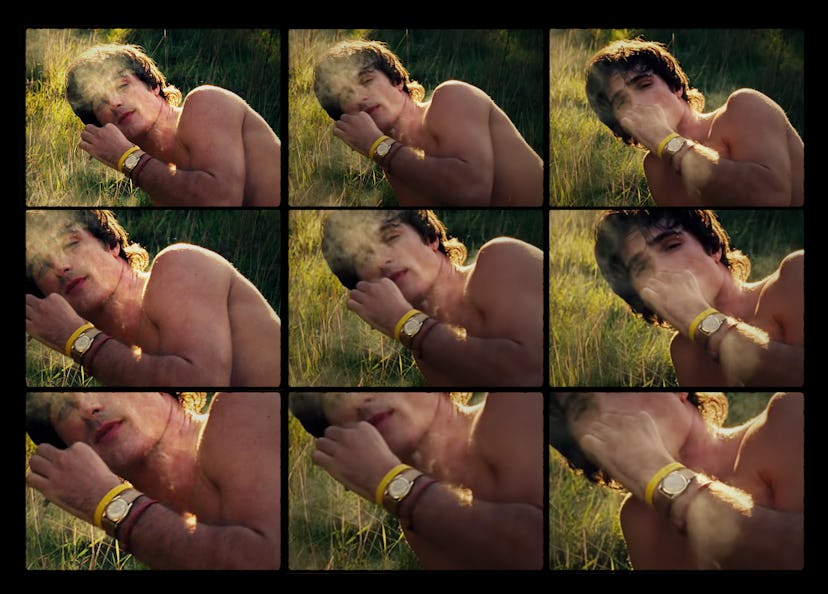Long Live The Livestrong
The True Genius Of Saltburn Lies In Jacob Elordi’s Favorite Accessory
His Livestrong bracelet speaks volumes.

To gaze upon Jacob Elordi in Saltburn is to gaze upon an embarrassment of riches. His alt rocker haircut. The always-popped, sometimes two-toned, collared shirts. Elordi’s own hulking, hunter-gatherer frame. And yes, the much mused-over eyebrow piercing. But there was one accessory that transfixed me and overshadowed all else: his Livestrong band. There it rests on his wrist, nestled alongside an antique watch and a red string just a hair too thick to be a Kabbalah bracelet, an undeniable totem of the early aughts.
Early on in Saltburn, we learn that it’s set in the recent past. A “Welcome Class of 2006” banner announces it and then, shortly after, a co-ed’s Juicy Couture sweatpants scream it. The banner sets audience expectations in another way, too: In identifying the freshman by their matriculation year instead of their expected graduation year, because Oxford’s courses vary in length, filmmaker Emerald Fennell proves she’ll do her utmost to honor the British aristocracy’s long-held, sometimes anachronistic traditions.
When it comes to the ’00s though, she’s more interested in style than substance. Aside from the MGMT needle drops and pieces from Kate Moss’ first-ever Topshop collection, the film — which follows Oliver (Barry Keoghan) and Felix (Elordi), two Oxford classmates from opposite sides of the tracks, who become best friends and spend the summer together at the latter’s palatial family estate, Saltburn — doesn’t feel like it lives in the Internet era. Partly, that’s because it’s so steeped in the pre-millennium stories it pays homage to: The Talented Mr. Ripley, but also Brideshead Revisited and The Secret History. And partly, it’s because so much of the film takes place in a 127-room manor, first erected around 1300, where Oliver and Felix lay around reading books rather than scrolling Twitter (which launched that year) and throw parties during which they live in the moment, rather than taking mobile uploads for Facebook. Early aughts ephemera serves only as decoration. The same rough plot could have unfolded centuries earlier, and it might make more sense if it had, given (limited spoilers) how seamlessly Oliver’s crimes unspool.
For better or worse, Fennell is most adept at poppy, aesthetic touches, preferring vibes to plot. Just take her debut film, Promising Young Woman, which was celebrated for its confectionery stylistic choices like a sexy nurse costume, candy-colored manicure, and a broken heart necklace — choices that also served to reveal more about the lead character, a 30-something who was still mourning her childhood best friend and unable to let go of the markers of their girlhood.
In Saltburn, it’s the Livestrong bracelet that speaks the loudest. Not convinced? Allow me a moment to remind you just how powerful the Livestrong bracelet once was. The yellow silicone wristband was first launched in May 2004 as a partnership between the Lance Armstrong Foundation and Nike, with the aim of raising money for cancer survivors. But the bracelets soon became a must-have fashion statement, which led to nationwide shortages (who among us didn’t force our parents to drive to every sports goods store in the tri-state area trying to get our hands on one?!) and a total of 55 million sold in the first year alone.
“Felix, the most beautiful man in the world, wears the worst clothes known to man,” Fennell recently told GQ. “Because boys like that don’t have to dress well.”
So, of course, ultimate cool guy Felix would have scored a Livestrong. But to still wear one over two years later — after its sales declined, Armstrong started facing doping allegations, and indie sleaze fashion had begun reigning supreme — isn’t exactly a flex. Rather, it’s a nod to how little Felix needs to flex at all. “Felix, the most beautiful man in the world, wears the worst clothes known to man,” Fennell recently told GQ. “Because boys like that don’t have to dress well.” While the squirrely, striving Oliver has to try at everything he does, Felix is able to glide guilelessly through life in his slouchy Abercrombie & Fitch rugby shirts, too-short Ralph Lauren V-necks, and Livestrong strong bracelet. He would never think to take it off in the same way that he never thinks too hard about anything, because when you’re that beautiful and that affluent, you don’t have to. Wristband or no, the world is yours for the taking.
And while many have argued that the class commentary the writer-director presents in the film is muddled at best, that slim, yellow band deftly embodies Felix’s relationship to his privilege — whether Fennell intended it to or not. Like a “woke” Instagram graphic before the advent of the platform, the Livestrong partially became cool because of the do-gooder-ism it symbolized — and because, like posting an infographic, buying a bracelet is easier than actually going out and doing something charitable. And this, too, is how Felix approaches being an obscenely rich “good guy.” He emphasizes the performance of it (touting around lesser-off loners) over actually practicing true goodness (plotting to redistribute his wealth).
If only Fennell had chosen to probe deeper into that kind of classic-specific tension, rather than letting the Livestrong do all the work.